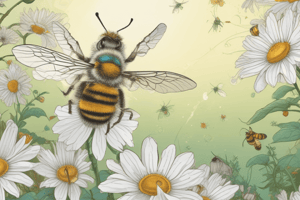Podcast
Questions and Answers
Which of the following is NOT a component of an ecosystem?
Which of the following is NOT a component of an ecosystem?
- Physical environment
- Living beings
- Relationships
- Economic factors (correct)
What is the difference between biotope and biocenosis?
What is the difference between biotope and biocenosis?
- Biotope is the physical space and its characteristics, while biocenosis is the set of living beings (correct)
- Biotope is the set of living beings, while biocenosis is the physical space and its characteristics
- Biotope and biocenosis are interchangeable terms
- Biotope refers to abiotic factors, while biocenosis refers to biotic factors
What is the main source of energy in ecosystems?
What is the main source of energy in ecosystems?
- Fossil fuels
- Water
- Sun (correct)
- Wind
What is the main difference between primary and secondary consumers in an ecosystem?
What is the main difference between primary and secondary consumers in an ecosystem?
Which of the following is NOT a biome found in Spain?
Which of the following is NOT a biome found in Spain?
What is the main function of decomposers in an ecosystem?
What is the main function of decomposers in an ecosystem?
What is the main difference between a food chain and a food web?
What is the main difference between a food chain and a food web?
What is a trophic pyramid based on the number of individuals?
What is a trophic pyramid based on the number of individuals?
What is the main difference between a herbivore and a carnivore in an ecosystem?
What is the main difference between a herbivore and a carnivore in an ecosystem?
Flashcards are hidden until you start studying
Study Notes
Components and Relationships in Ecosystems
- An ecosystem is formed by a physical environment, living beings, and their relationships.
- The biotope and biocenosis are the two fundamental parts of an ecosystem.
- The biotope is the physical space and its characteristics, while the biocenosis is the set of living beings.
- Abiotic and biotic factors are components of the biotope and biocenosis that condition the life of organisms.
- Abiotic factors can be physical, such as temperature and rainfall, or chemical, such as soil composition and pH.
- Tolerance limits are the values of parameters that allow survival in an ecosystem.
- Biotic factors are living beings and their relationships with the physical environment.
- Intraspecific relationships occur between organisms of the same species, such as competition and cooperation.
- Interspecific relationships occur between organisms of different species, such as competition, predation, and mutualism.
- Living beings present adaptations to both abiotic and biotic factors.
- Energy and matter flow through ecosystems in food chains, food webs, and trophic pyramids.
- The Sun is the main source of energy, which is transformed into chemical energy by plants and travels through organisms.
Ecosystems and Trophic Levels
- There are three trophic levels: producers, consumers, and decomposers
- Producers are autotrophic organisms that transform inorganic matter into organic matter using the energy of the sun
- Consumers are heterotrophic organisms that feed on other living things
- Primary consumers are herbivores that feed on producers or plants, while secondary consumers are carnivores or omnivores that feed on primary consumers
- Decomposers are heterotrophic organisms that feed on the remains of living beings, transforming organic matter into inorganic matter
- Food chains, food webs, and trophic pyramids are used to represent the trophic relationships in an ecosystem
- Biomes are sets of terrestrial ecosystems that share similar climatic conditions and similar biocenoses
- Biomes can be classified into cold climate zones, mild climate zones, and warm climate zones
- The biodiversity of ecosystems in Spain is very high due to its geographical position, orography, and the existence of archipelagos
- The main ecosystems in Spain include the Atlantic or deciduous forest, Mediterranean or sclerophyllous forest, dehesa, Mediterranean scrub, and marine and inland water aquatic ecosystems
- The soil is an ecosystem that has a biotope and biocenosis, and is formed when the atmosphere, hydrosphere, and biosphere erode rocks
- A mature soil contains different horizons such as horizon O that contains humus, horizon A that contains dark-colored humus, horizon B that contains light-colored salts, horizon C that contains bedrock fragments, and horizon R that is the unaltered bedrock
Trophic Levels, Food Chains, Trophic Pyramids, and Types of Ecosystems
- There are three trophic levels in ecosystems: producers, consumers, and decomposers.
- Producers are autotrophic organisms that transform inorganic into organic matter using the energy of the Sun.
- Consumers are heterotrophic organisms that feed on other living things, including primary consumers (herbivores) and secondary consumers (carnivores or omnivores).
- Decomposers feed on the remains of living beings, transforming organic matter into inorganic.
- Food chains, food webs, and trophic pyramids are used to represent the trophic relationships of an ecosystem.
- A food chain is the simplest representation, showing a linear sequence of organisms that eat each other.
- A food web shows all possible food relationships between organisms in an ecosystem.
- A trophic pyramid represents the trophic levels, with producers at the base, followed by primary consumers, secondary consumers, and so on.
- There are three types of trophic pyramids: based on the number of individuals, biomass, or amount of energy in each level.
- Biomes are a set of terrestrial ecosystems that share similar climatic conditions and similar biocenoses.
- The main ecosystems in Spain include the Atlantic or deciduous forest, Mediterranean or sclerophyllous forest, dehesa, Mediterranean scrub, and marine and inland water aquatic ecosystems.
- Inland water aquatic ecosystems include wetlands, lakes and lagoons, and rivers, streams, and springs, and they are normally freshwater.
Studying That Suits You
Use AI to generate personalized quizzes and flashcards to suit your learning preferences.





